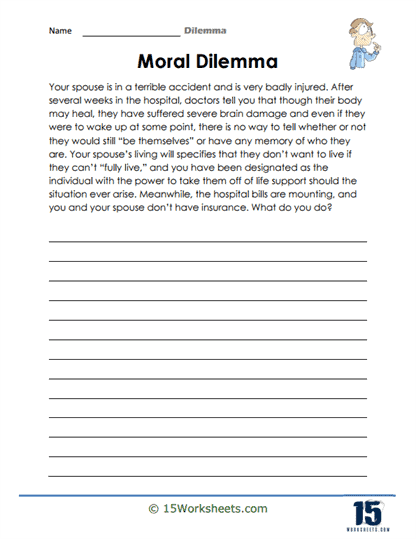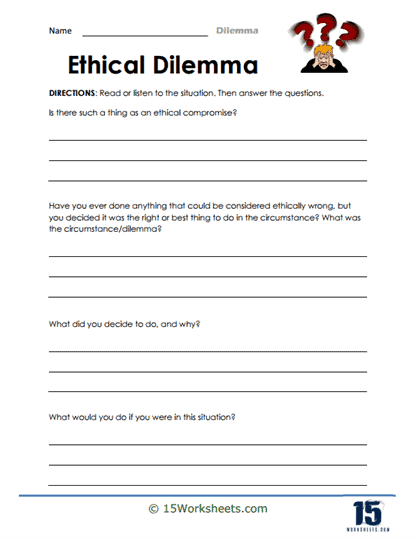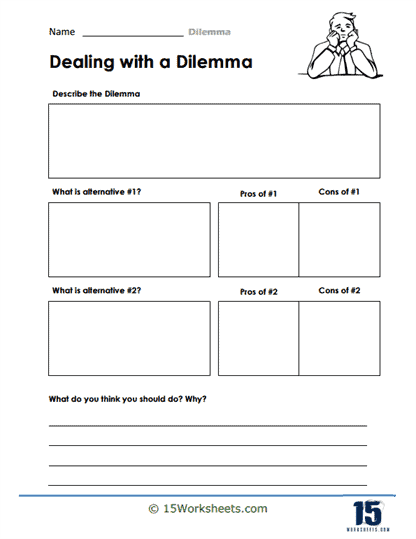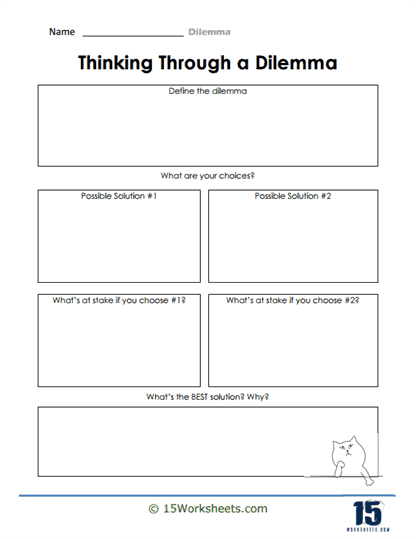Dilemma Worksheets
About These 15 Worksheets
These worksheets can help enhance students’ understanding and skills in language arts and reading. These worksheets focus on presenting dilemmas or complex situations that require critical thinking, analysis, and decision-making, offering a multifaceted approach to learning. By engaging with these worksheets, students not only refine their comprehension and interpretation skills but also improve their ability to articulate thoughts, argue positions, and understand multiple perspectives. This detailed exploration will cover the essence of Dilemma Worksheets, the various exercises they encompass, and the ways in which they bolster language arts and reading proficiencies.
At their core, Dilemma Worksheets are structured around hypothetical or real-life situations that pose a moral, ethical, or practical problem without an obvious right or wrong answer. These scenarios compel students to weigh options, consider consequences, and justify their decisions, thereby fostering a deep, reflective form of learning. The dilemmas are carefully crafted to be age-appropriate and relevant to the students’ experiences, making the exercises both engaging and thought-provoking.
Through a diverse range of exercises, they challenge students to think deeply, argue effectively, and understand complex texts and human experiences. By integrating these worksheets into their learning, students significantly enhance their comprehension, analytical, writing, and empathetic skills, laying a solid foundation for academic success and personal growth in language arts and beyond.
Types of Exercises
Moral and Ethical Dilemmas – These exercises present situations involving moral or ethical questions, pushing students to consider values, principles, and the impact of actions on others. For instance, a worksheet might pose a dilemma about whether to return a lost wallet found with a substantial amount of money, challenging students to debate honesty versus personal gain.
Problem-Solving Scenarios – These are designed to develop students’ analytical and problem-solving skills by presenting complex situations that require a strategic approach to find solutions. An example could involve organizing a school event with limited resources, encouraging students to prioritize, negotiate, and innovate.
Critical Thinking Questions – Accompanying each dilemma are questions that prompt critical reflection on the scenario, asking students to identify the key issues, predict outcomes, and consider the perspectives of different stakeholders involved.
Role-Playing Activities – Some worksheets incorporate role-playing exercises where students assume the roles of characters within a dilemma. This immersive approach helps them understand diverse viewpoints and the complexities of human behavior and decision-making.
Creative Writing Prompts – Students might be asked to write essays, diary entries, or letters from the perspective of one of the characters involved in a dilemma. This exercise enhances writing skills, empathy, and the ability to express nuanced thoughts and emotions.
Debate and Discussion Guides – Worksheets often include guidelines for structured debates or discussions, enabling students to articulate their positions, listen to others, and engage in respectful argumentation.
Reflection and Personal Connection – Exercises that encourage students to relate dilemmas to their own experiences or current events help in making the learning process more personal and impactful. Reflecting on how they would navigate similar situations in real life fosters personal growth and ethical reasoning.
Benefits of These Worksheets
Practicing with Dilemma Worksheets offers numerous advantages for students’ development in language arts and reading. Firstly, these worksheets enhance reading comprehension by requiring students to grasp complex narratives and underlying issues within the dilemmas. As students dissect the scenarios, they hone their ability to extract key information, infer meanings, and understand subtleties in texts.
The varied exercises improve critical thinking and analytical skills. Students learn to evaluate evidence, distinguish between facts and opinions, and synthesize information to support their viewpoints. This analytical prowess is crucial for interpreting literature, understanding persuasive texts, and engaging with a wide array of reading materials.
These worksheets bolster writing and communication skills. Through writing exercises and debates, students practice constructing coherent arguments, using persuasive language, and expressing their thoughts in a clear and compelling manner. This practice is invaluable for essay writing, presentations, and any form of academic or creative writing.
Engagement with moral and ethical dilemmas also enriches students’ emotional intelligence and empathy. By considering the perspectives and emotions of different characters, students develop a deeper understanding of human behavior and social interactions. This empathetic engagement enhances their ability to read and interpret literary characters, themes, and narratives, deepening their appreciation for literature. The interactive nature of the exercises keeps students invested in the learning process, fostering a love for reading and discussion. This active involvement is key to developing a lifelong interest in language arts and reading.
What is the Literary Device of Dilemma?
The literary device of dilemma plays a critical role in storytelling, offering depth and complexity to narratives that captivate readers’ attention and provoke thought. A dilemma is a situation in which a character is faced with a difficult choice between two or more alternatives, often with significant consequences regardless of the decision made. This literary tool is not merely a plot device but a profound means to explore the human condition, ethical quandaries, and the multifaceted nature of decision-making. This essay will delve into the essence of dilemma in literature, its defining features, characteristics, and the impact it has on readers through three illustrative examples.
Defining Feature of a Dilemma
The main defining feature of a dilemma is the necessity for a character to make a choice between two or more equally undesirable or mutually exclusive options. This choice is crucial because it often results in significant consequences for the character, other characters, and the narrative’s progression. Unlike simple conflicts, dilemmas are intricately tied to the internal and external struggles of characters, reflecting deeper themes of morality, duty, loyalty, and personal ethics.
Characteristics of a Dilemma
Equally Undesirable Options – The choices presented in a dilemma are often equally unappealing, and the character must weigh the outcomes of each decision carefully.
Moral or Ethical Conflict – Dilemmas frequently involve a moral or ethical component, forcing the character to examine their values and the implications of their actions.
No Clear Right or Wrong Answer – Unlike other conflicts, dilemmas typically do not have a clear-cut solution. The ambiguity in choosing highlights the complexity of human nature and ethical considerations. The decisions made in response to a dilemma carry significant consequences that impact the character’s journey and the story’s outcome.
Character Development – Dilemmas are instrumental in character development, revealing the character’s priorities, values, and personality traits.
Engagement of the Reader – A well-presented dilemma engages readers, prompting them to think about what they would do in a similar situation, thereby deepening their connection to the narrative.
Examples of Dilemma in Literature
“To Kill a Mockingbird” by Harper Lee – Atticus Finch faces a moral dilemma when he decides to defend Tom Robinson, a black man wrongly accused of raping a white woman in the racially prejudiced setting of the American South during the 1930s. Atticus’s decision places him and his family in social jeopardy, pitting his sense of justice and moral integrity against the bigotry of his community. This dilemma highlights the themes of racial injustice, moral courage, and the cost of doing what is right in the face of overwhelming opposition.
“Hamlet” by William Shakespeare – The titular character Hamlet encounters a profound dilemma after the ghost of his father reveals that he was murdered by Hamlet’s uncle, now the king. Hamlet’s dilemma revolves around avenging his father’s death or abiding by his moral and religious belief that vengeance is wrong. This internal conflict drives the plot, showcasing Hamlet’s indecision, moral integrity, and the tragic consequences of his eventual actions, engaging readers in a deep philosophical and ethical exploration.
“The Road” by Cormac McCarthy – The protagonist and his son face numerous dilemmas in this post-apocalyptic novel, one of which involves whether to help a thief who stole from them. The dilemma explores the balance between survival and maintaining one’s humanity in a world devoid of societal norms and ethics. This instance highlights the themes of survival, morality, and the human capacity for kindness in the face of utter despair.
Effect of Dilemma on the Reader
The use of dilemma in literature has a profound effect on readers, engaging them on both an intellectual and emotional level. Dilemmas force readers to grapple with the same questions and choices that characters face, fostering empathy, introspection, and a deeper understanding of the human condition. Readers are compelled to consider what they would do in similar situations, thus bridging the gap between fiction and reality and making the narrative more relatable and impactful.
Dilemmas stimulate readers’ critical thinking and moral reasoning, encouraging them to reflect on their own values, beliefs, and the complexities of ethical decision-making. By presenting characters with difficult choices, authors invite readers into a shared space of moral ambiguity and complexity, enriching the reading experience.
By presenting characters with difficult choices, dilemmas explore the nuances of the human condition, moral and ethical conflicts, and the profound consequences of our decisions. Through examples like “To Kill a Mockingbird,” “Hamlet,” and “The Road,” we see how dilemmas not only drive the narrative forward but also engage readers in a deep, reflective process, enhancing their understanding of literature and life itself. The effective use of dilemmas in storytelling underscores the power of literature to mirror the complexities of real-life decision-making, ultimately enriching the reader’s experience and understanding of the world.















